Yakawlang – Harvest Day
“Harvest this year is not so good” – Qabir, Yakawlang FAO training officer
First, let’s see some facts about Afghanistan. About 75% of the total area is mountainous, leaving only small part of the country cultivated. From the lowland art, a big percentage located in wasteland in the southern desert. In the mountainous areas, water and weather are always big problems. Thus, the 25 million population needs wheat and rice to be consumed everyday. In this war torn agricultural country, food problem is among the biggest problems to be solved. Ghor province is among the least developed provinces in Afghanistan. Water is so limited and terrain is difficult. Agriculture can not develop much here.

Shahtu Pass, 3350 m, one of the mightiest high passes in mountainous Afghanistan, separates Panjao from Bamiyan.
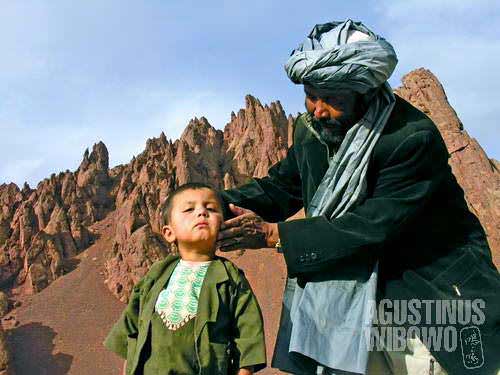
A Hazara man directing his son to pose in front of the camera on the top of Shahtu Pass, Yakawlang, Bamiyan. Shahtu is among the incredible mountain passes in Afghanistan, 70 percent of which area are mountainous.

The Hazarajat, or area inhabited by Hazaras, is much more fortunate compared to Ghour. Water is quite plentiful here.
But at the eastern part of the province, the Lal o Sar Jangal district, live the though Hazara ethnics, descendants of the Mongoloid race. The Hazara, whose homes are not walled as much as those of other Afghan brothers, developed traditions of cultivating the difficult terrains of steep hill slopes and valleys. Lalmi, the cultivation on the hill slopes, is one of the most important agricultural productions in Afghanistan. The hills are not irrigated. Water only relies on rains or snowfalls. A lalmi farmer should know exactly when to start to cultivate the hills, considering the temperature, altitude, fertility of soil, and most importantly, the timing when water ‘from heaven’ comes. This is not something that human can always control. Sometimes the rain is few and snowfall is not enough, then the whole population is threatened by starvation as the wheat and barley die of drought.
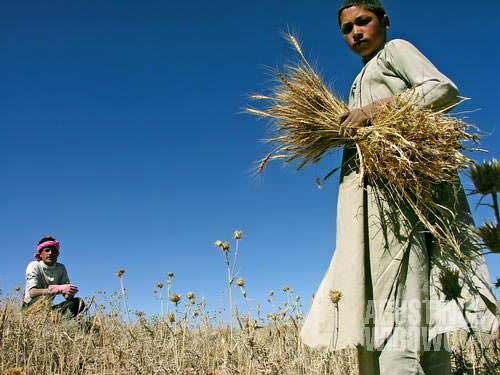
Hazara farmers near the Band-e-Amir lakes harvest wheat produced by Lalmi field. Lalmi is a traditional method of agriculture: cultivating wheat on cliffs of mountains without any system of irrigation, relying completely on natural rain or snow.
Such a fragile food cultivation still plays important role in feeding the country. The neighbouring Bamiyan province, also dominated by Hazara minority, is much luckier. Water is abundant here, due to the almighty Band-Amir lakes. Crossing the Kirman Pass which bordered the two provinces, the landscape turned drastically from barren and dusty hills of Ghor province to be green valleys of Bamiyan.
Here lalmi also plays a vital role in food production, but irrigated agricultural system, called ‘abi’ also exists. When I passed the villages of Bamiyan, most of the lalmi fields had been harvested and the people were harvesting wheat from the abi fields.
Is wheat produced by naturally watered lalmi fields compared to that of the manually irrigated abi fields? “I prefer wheat from lalmi,” Ibrahim, a Hazara truck driver said, “as it is whiter and sweeter. The price of the two is the same anyway.”
Harvest, in traditionally agricultural community is something to be praised and thanked. In Yakawlang district, on September 20, 2006, a French NGO conducted a Jeshn, means festival, to celebrate the successful harvest in the district. It was a happy scene to see the farmers from villages came to the field of bazaar of Yakawlang enthusiastically. They brought their best harvest product to show. If a 2 kg potato didn’t surprise you, you should see the size of the giant pumpkins, or see Hayatullah with his two terribly fat sheep. The farmers were happy. The sheep, horses, donkey, were decorated as they were joining a beauty contest. The women also came with their best handworks, from curtains until small carpets. Bennoit, the organizer of the festival from the French NGO, Solidarites, didn’t expect the enthusiastic respond from the villagers. There were more than 130 women participating in the village’s big day, and this made Bennoit very happy.
Bennoit delivered a speech in Farsi, and his mispronunciations was kind of entertainment for the people. The commander of Yakawlang as well some other people from the government officials and the NGO also delivered long speeches.
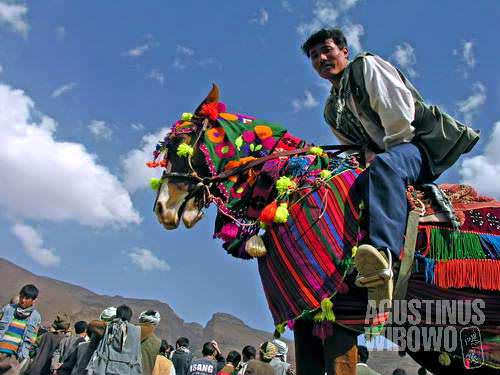
A Hazara farmer rides his beautifully decorated horse, in a harvest festival in Yakawlang. Farmers from all corners of the district come with their best product to show and to share the happiness with others.
Were all people happy with today’s colourful festival?
Qabir, a staff of FAO showed his regret. “Today they only talked about Solidarites, Solidarites…, Solidarites… They didn’t talk anything about FAO programs. We worked a lot in this area, but they talked almost nothing about us.” Qabir gave me some examples about the FAO programs, like farmer training and lalmifield allocation. “Harvest this year is not so good. Rain didn’t come. I don’t know why this celebration. It’s merely publication for Solidarites.” Indeed, the festival was conducted by the Solidarites, the ‘small’ French NGO. They invited an Afghan national TV, Ariana, to cover the moment.
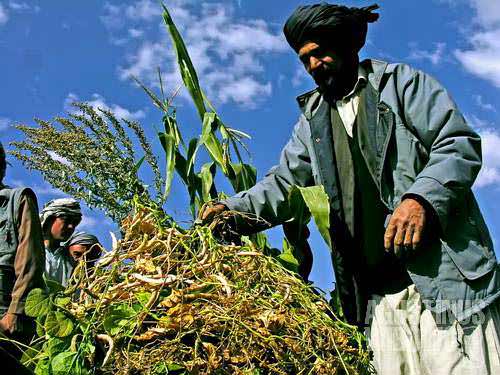
A Hazara farmer is exhibiting his successful harvest and his best products from the field in a agricultural harvest festival (Jeshn) to celebrate the successful harvest season in Yakawlang district of Bamiyan.
But for Bennoit, it was not merely about publication. Even though he also expressed his regret that almost all people invited to deliver speech were only talking about Solidarites and left very little time for the villagers to show their harvest product, he emphasized the meaning of the festival. “All organizations will tell you that the harvest is not good,” said Bennoit, “but for sure there is achievement compared to previous years.” The farmers were happy and you could see easily see from the respond of the women who were very proud showing their beautiful works. The commander was also invited to deliver speech, and it would make impression to the villagers that Solidarites was also supported by the government. Bennoit told me that sometimes the police harassed the NGO’s activities. “They don’t understand our work. Sometimes suspect us as smugglers of Afghan antiques. The other times, after we do something, they expect us to do everything for them. We have big budget, I admit, but we want to encourage the locals to support themselves.”
The coverage by the national TV was also a very big plus point. “People will feel that Yakawlang is part of Afghanistan. Yakawlang is not forgotten by Afghanistan.” The reporter and cameraman of Ariana didn’t only cover the festival activity, but also interviewed the villagers, let them to say freely anything they want the government to hear, in front of the camera. An old farmer from a village in the district said, “Our village is far from bazaar. In winter the snow can be very high. We don’t have road to go to bazaar. It’s very difficult. We want the government to build road for us.” It was just a simple wish from an old villager, but it also showed the fact the people expected the government to work harder in rural areas. Simple and honest.

Hazara farmers with giant sunflowers. The farmers are showing their best agricultural product of the year in a harvest festival (Jeshn) conducted by Solidarites, a French NGO working in the area.
Was the harvest that bad? I met Qurban and his son were harvesting their wheat in a village near Band-e-Amir lake. “We produced only 250 sir, it is about 15000 Af, for our 4 month work. At our best harvest we can earn up till 50,000 Af.”
How about the lalmi?
He pointed a barren hill with dry lalmi patchwork. “You see that? That is our field. How much it produced? Nothing. Nothing. Hich!”
His neighbour, Shir Ahmad, also expressed the same fate. All lalmi in the area was failed, as there was no rain at all. What they could harvest was only that from the irrigated field (abi). He was ‘grilling’ the wheat with the help of two cows, of which mouths were covered to prevent them eating the wheat. They were about to sell the harvest product to the bazaar of Yakawlang. Shir Ahmad expected to earn 12,000 Af in total.
About 10 km away from this village, another village was celebrating better harvest. Ahmadullah was harvesting his lalmi field with his whole family. “Yes, harvest this year is not as good as before. Rain was so few.” His lalmi field was just located almost next to the lake of Band-e-Bala.
Nevertheless, people of Bamiyan were not that suffering, as there are mighty lakes of Band-e-Amir empowering their life. “Drought never really comes to Bamiyan,” said Bennoit, “and these people are not that poor.” With good security situation and abundant aid from foreign organizations, people of Bamiyan may expect a better future, soon.

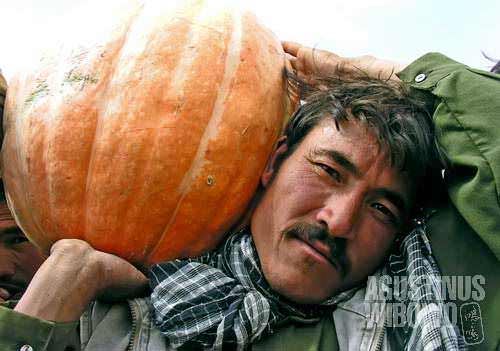
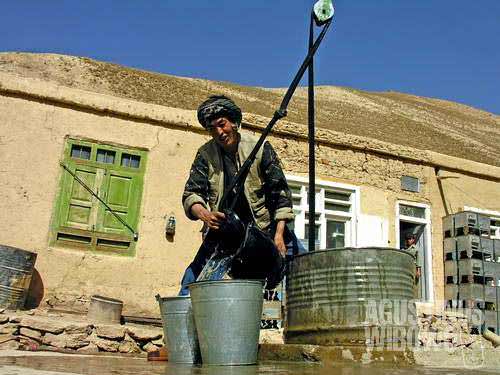
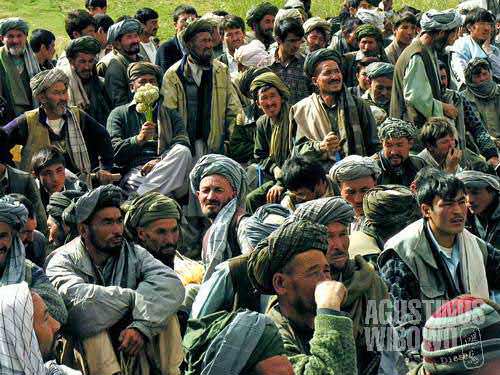
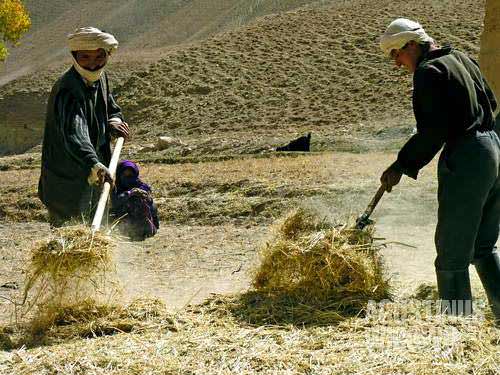





Leave a comment